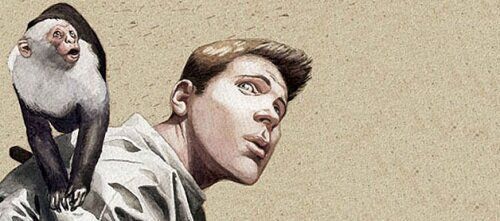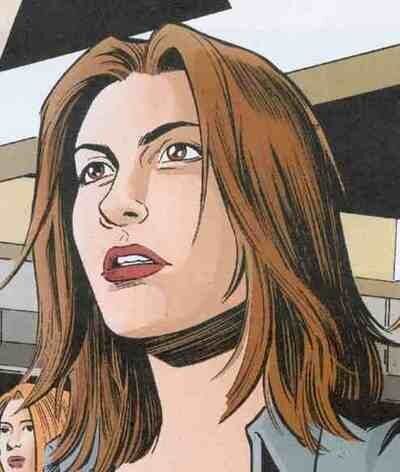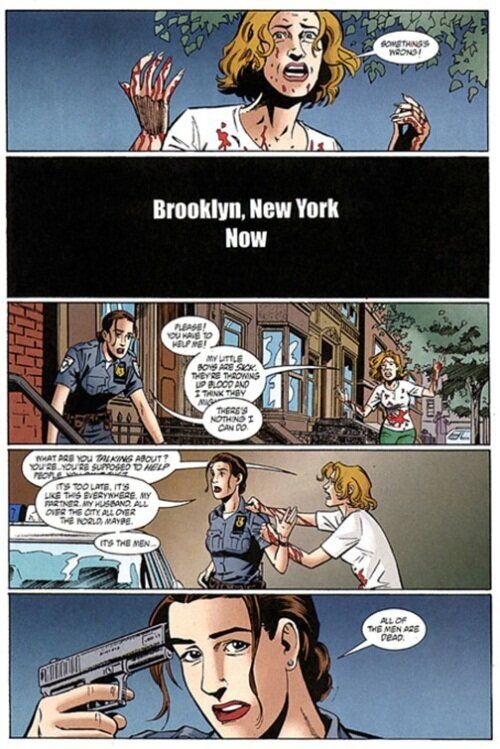It has been ten years since Y: The Last Man was released, and we are still feeling the after-effects of this ground-breaking comic series. Released through the Vertigo imprint of DC Comics, series creator Brian K. Vaughan took what was already established, and pushed the envelope of what was possible to new levels during the sixty-issue run. The results of Brian's efforts witnessed the bar being raised for all that came after. Rarely have the words "a modern classic" been so appropriate.
The premise of Y: The Last Man is not an original one: a lone survivor of a catastrophe that decimated mankind seeks to understand what happened. However, Brian K. Vaughan reinvents this premise, taking the phrase "mankind", to mean exactly that, in that anything possessing the Y Chromosome was killed. This Gendercide, as the plague is called, kills every male on Earth, with the exception of an escape artist called Yorrick Brown. What follows is essentially an extended road-trip across the globe, where we explore this new world that Yorrick finds himself in, as Brian K. Vaughan elevates an unoriginal idea into an examination contemporary of gender politics.
Despite the gendercide being a core element of the series, we are never given a definitive answer as to the cause. For Brian K. Vaughan, the cause of gendercide was not of consequence; instead he was fascinated by the effects that this would have upon our society. Theories postulated by characters within the series vary from the Biblical Rapture, an ancient curse, to the Y-Chromosome becoming obsolete after the successful birth of a human clone. But one explanation in particular, that an unexpected consequence of an attempted sabotage caused the gendercide, is the one for which we are provided the most detail. Given this detail, it is assumed that is the most likely explanation.

Yorrick Brown, Agent 355 and Dr. Alison Mann are the principal characters in Y: The Last Man. Yorrick is the last man alive on the planet, and his occupation - an escape artist - was not chosen lightly, for he literally escapes certain death. Yorrick is of course one of the few masculine names that start with the letter "Y", which alludes to the Y-Chromosone. Yorrick's character evolves throughout the series. At first Yorrick's niavety forces him to rush into confrontation, needlessly exposing himself to danger; yet as he learns from the consequences of his actions, he matures and takes a less direct approach to confrontations.
It is through Yorrick that much of the story evolves. Whilst others attempt to learn why Yorrick was immune to the Gendercide, Yorrick's far more personal quest is to find his girlfriend; Beth DeVille, who was in the Australian outback at the time of the Gendercide. Like much of Y: The Last Man, this is a very typical storytelling trope that has been wonderfully re-imagined in Brian K. Vaughan's writing.
Beth's role within the series was minor yet significant. Yorrick's drive to find his girlfriend and consummate his proposal moves the story forward, as he travels across globe looking for his lost love. However, Beth is never portrayed as being the boon for completing the hero's journey through darkness, as she is far more capable than Yorrick. This portrayal is diametrically opposed to her appearances in Yorrick's dreams. In these dreams, whether they be fantastical swords-and-sorcery or science-fiction space-opera, Beth is always portrayed in the subordinate role.

Agent 355 of the Culper Ring is Yorrick Brown's government-sanctioned body-guard and direct opposite. Barring the opposites in their gender and race, their characters are diametrically opposed too: Yorrick often takes submissive/passive role of an observer, whilst Agent 355 confidently assumes the dynamic/assertive role of the leader and protector of the group.
Like Yorrick Brown, Agent 355's character similarly evolves throughout the series. Initially Agent 355 begins as an uncaring field-agent who kills without remorse, yet the number of lives she is forced to take ultimately cause her to question her methods, and have her accept responsibility for all the death she has caused.
Finally, it is no surprise that the geneticist Dr. Alison Mann's name was carefully chosen: A. Mann. Dr. Mann's character is the one out of the core-group that is least explored, for a lot of her background is inherently woven into the story's background. This acts as a lynch-pin for the more plot-centric story-lines, and so we are often exploring the plot, rather than character, when following these story-lines. Thus her character evolves only in terms of her opening up, and overcoming the guilt she feels for her role in the Gendercide.
It is with these three characters that we explore a world without men, and the implications of this. It is an elegantly simple premise that Brian K. Vaughan extends to its logical conclusions, examining every aspect of this new world, from biology and zoology to geo-politics and sociology.
One result of the Gendercide we witness is the growth of an Amazon cult. Victoria, the cult's leader, espouses a aggressive feministic ideal, where she lays the blame for the subjugation of women at men's feet (and in part Victoria is right), and claims that the Gendercide was Gaia's doing: ridding the world of the masculine destroyer to make for the feminine creators. The Amazons quickly become the initial core antagonists for the series, with their mission to fulfil what Gaia had failed to accomplish: the eradication of the all men; the death of Yorrick Brown.
As part of the initiation ritual into the Amazon cult, potential applicants must remove their left breast. This deliberate mutilation is interesting, as it removes a symbolic element of their femininity whilst allowing them to more effectively use a bow, the weapon of choice for the original Amazon, thereby making them more effective warriors.

One member of the Amazon Cult who becomes increasingly important is Hero Brown, Yorrick's older sister and former emergency medical technician. Hero's character begins as a minor role, but soon becomes a major player within the story. One of the critical points of Hero's journey is her decision to leave the Amazon cult, and her subsequent quest to redeem herself for the evil she caused whilst a member of the cult.
Like the others, Hero's name was carefully chosen: not only does she have a Shakespearean name like her brother, but Hero also begins to assume the mantle that her name suggests. Neither is it a random decision over the choice of clothes that Hero later wears, which are those of the cowboy (how many adolescent boys wanted to be cowboys?).
Despite the Amazons being the initial primary villain, the Israeli Defence Force leader Alter later comes to the fore as the primary antagonist for the series. Alter is an unusual first name in Israel, as it literally means "old man" in Hebrew. Following the death of her younger siblings, her parents named her Alter, believing in the superstition that since the Angel of Death would not know her true-name, he would be unable to find her.
The reason Alter offers for chasing Yorrick - so that he may be used as leverage against Israel's enemies - is not her true reason. Like Yorrick, Alter shares survivors' guilt following the death of her siblings, yet unlike him Alter was unable to move beyond her guilt. Despite Alter assuming command of the Israeli Defence Force, an inherently masculine organisation, her personal reasons for hunting Yorrick indicate she has never truly left behind the patriarchal society.

Structurally, Y:The Last Man redefined comic reader expectations, by successfully employing narrative techniques that were rare for the comics medium at that time. It was not uncommon for Y: The Last Man to open in-media-res, or use flashbacks, both of which are now common techniques in the medium today.
The use of these storytelling tropes was dramatically different to conventional graphic novels at the time, and it can be said that the current popularity of these tropes can be traced back to this seminal series. Vaughan is unafraid to add thematic nods in a character's flashbacks, which are used further explore the character's motivations. The opening issue of Y: The Last Man is a blend of these two elements, where it opens as the Gendercide hits, before flashing back half an hour, to show the events leading up to the catastrophe, giving a balanced introduction to all of the principal characters.
The individual issues of Y: The Last Man were never without some excellent cliff-hangers. The only downside to this is that the graphic novels for the story-arcs that make up the series sometimes feel incomplete given their conclusion ends on a cliff-hanger, which leads into the subsequent volume.
Consequences play an important role in this series, as we often see the results of a character's actions. Here, characters do not cheerfully gun down their opponents, and soldier on. Instead, there is an emotional price for these actions, which causes them to evolve throughout the series. For example, at the start Yorrick continually takes risks, due to his subconscious desire for death after the gendercide, and following his suicide intervention, he pauses to think before taking action.
The artwork in Y: The Last Man is both crisp and clear, and could be described as bold without being gratuitous. In many ways, the artwork reminds me of Steve Dillon's work on Hellblazer. Characters are always presented realistically, and the violence is similarly presented with a clear view as to the harm that is caused.

Reading Y: The Last Man, it is interesting to note how often the letter "Y" appears. It is obviously no mistake that Yorrick is called what he is (just how many male names beginning with "Y" are there? Not many). Similarly, there are a significant number of times when the shape of the letter "Y" appears in the background, varying from road junctions to tree-branches. This recurring symbol of the "Y" character adds little to the series per-se, but reinforces the gender themes running through the series.
It would be very easy to claim that Brian K. Vaughan upholds feminist ideals, however I do not feel that is entirely true. Instead, I would conjecture that Brian K. Vaughan is more focussed on gender-equality, as he uses Y: The Last Man to examine both the male and female gender roles to create a more balanced view. Just as the Amazon's leader Victoria espouses that humanity's evil is perpetrated by men, others are just as likely to counter her argument with similar atrocities committed by women (If you require any validity of this, I ask you to consider that the world's most prolific serial killer was Mary Ann Cotton, as Bryan Talbot has commented in the ground-breaking Alice in Sunderland).
Yorrick, as the every-day man rarely commits acts of aggression. That is not to say he is passive, as he acts when his heart tells him, but he is rarely physically violent, and only is so when reacting to the violence of others. This physical equality that is exhibited by women is designed to skew the reader's perception, and make us question contemporary gender-politics and stereotypes.
One of the most fascinating aspects to Y:The Last Man is the examination of gender roles, especially that of women, between different cultures, and the extrapolation of the ramifications that this would have if the male of our species were destroyed. This is placed in stark relief in the first issue, where we are given a hint of the direction that the series will take, when Brian K. Vaughan lists a series of statistics showing the men:women ratios in different careers in different countries. Whilst this may make for dry-reading, it is an endlessly fascinating examination of our culture.
Despite ten years having passed since this comic was first published, the socio-political and cultural examination that Y: The Last Man offers remains just as valid today as it did a decade ago. Perhaps it is time you gave the last man a second chance?